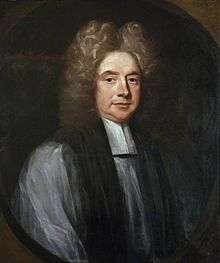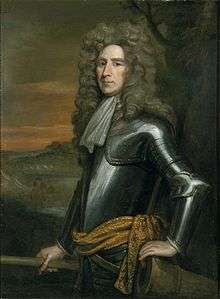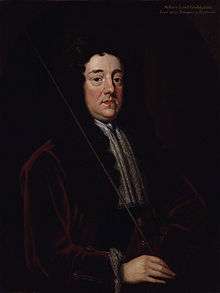Charles Trelawny
Major General Charles Trelawny, also spelt 'Trelawney', (1653 – 24 September 1731) was an English soldier and Tory politician, who was a Member of Parliament, or MP, for various seats between 1685 to 1713.
Charles Trelawny | |
|---|---|
.jpg) The family home, Trelawne Manor | |
| Born | ca 1653 Trelawny House, Pelynt |
| Died | 24 September 1731 Hengar, Cornwall |
| Buried | |
| Allegiance | |
| Service/ | Army |
| Years of service | 1673-1692 |
| Rank | Major General 1690 |
| Unit | Colonel, 4th Foot[lower-alpha 1] 1682-1692 [lower-alpha 2] |
| Commands held | Governor of Dublin 1690 Governor of Plymouth 1696-1720 Vice-Admiral of South Cornwall 1702-1710 |
| Battles/wars | 1672-1678 Franco-Dutch War Maastricht 1673 Enzheim 1674 Altenheim 1675 Tangier Garrison 1680-1684 Monmouth Rebellion Sedgemoor 1685 Williamite War in Ireland 1689-1691 The Boyne Siege of Cork 1690 |
| Relations | Sir Jonathan Trelawny, 1623-1681 (Father) Sir Edward Seymour 1632-1708 (Uncle) Sir Jonathan Trelawny 1650-1721 (Brother) |
| Other work | Member of Parliament East Looe 1685-1687 & 1689-1698 Plymouth 1698-1713 |
Trelawny began his military career in 1673, and held a number of senior commands under Charles II. Like many Tories, he backed the succession of James II in 1685, despite his Catholicism; his defection in 1688 illustrated the extent to which James had alienated his primary support base.
His elder brother, Sir Jonathan Trelawny, was one of the Seven Bishops whose prosecution and subsequent acquittal destroyed James' political authority. With his friend and colleague John Churchill, later Duke of Marlborough, he helped organise military support for the November 1688 Glorious Revolution. James was replaced by his Protestant daughter Mary, and Dutch son-in-law William of Orange.
Trelawny served in the 1689 to 1691 Williamite War in Ireland, before resigning his commission in 1692. He remained an MP, and acted as political manager in Cornwall and Devon for his fellow Cornishman, Sidney Godolphin, Lord High Treasurer from 1702 to 1710. He left Parliament in 1713, and lived quietly at home, where he died in 1731.
Early life
Charles Trelawny was born in 1653, fourth son of Sir Jonathan Trelawny (1623-1681) and Mary Seymour (1619-1680), daughter of Sir Edward Seymour (1610-1688), a junior branch of the Dukes of Somerset. His siblings included John (1646-1680), William (died young) Jonathan (1650-1721), Henry (1658-1702) and Chichester (died 1694).[1]
On 1 May 1690, Trelawny married his cousin Anne Morice (1672-1690), widow of William Morice (1660-1688), MP for Newport in Cornwall from 1681 to 1688.[2] Anne's father, Richard Lower (1631-1691), was Court physician until losing his position in 1681 due to the Exclusion Crisis.[3]
The Lowers were another prominent West Country family and when Anne died in childbirth in 1690, Trelawny inherited her estates near Hengar, Cornwall. Trelawny remarried in June 1699, this time to Elizabeth Mitchell, whose father Thomas was Rector of Notgrove, Gloucestershire. They had one surviving daughter, of whom little is known; Trelawny left his lands and property to his nephew Edward.
Career
Europe and Africa; 1673-1684
.jpg)
The 1638-1651 Wars of the Three Kingdoms created strong resistance in Scotland and England to a professional army and those who wanted a military career usually did so in foreign service.[4] In the 1670 Treaty of Dover, Charles II of England agreed to support a French attack on the Dutch Republic and supply a British Brigade of 6,000 troops for the French army. Louis XIV paid him £230,000 per year for this, a secret provision not revealed until 1775.[5]

When the Franco-Dutch War began in 1672, Trelawny joined the Royal English Regiment, recruited as part of the Brigade. The alliance with Catholic France was deeply unpopular; many doubted its reliability against the Protestant Dutch and so it served mainly in the Rhineland. However, some officers took part in the 1673 siege of Maastricht as volunteers, including Trelawny and John Churchill, later Duke of Marlborough.[6]
The Third Anglo-Dutch War ended with the February 1674 Treaty of Westminster, the wider Franco-Dutch War continuing until 1678.[7] Although many Brigade members transferred to the Dutch military, Charles encouraged others to remain to retain his payments from Louis. In March 1674, Trelawny became a captain in the second battalion of the Royal English, led by Bevil Skelton.[8] From 1674 to 1675, his unit served under Turenne at the battles of Enzheim and Altenheim; declining numbers and domestic opposition meant the Brigade was dissolved in 1676.[9]
In July 1680, Trelawny was appointed major in the 2nd Tangier Regiment, raised for service in the Tangier Garrison. An English possession since 1662, its garrison suffered heavy losses from disease and combat; his eldest brother, John was killed there in May 1680. The regiment was commanded by an illegitimate son of Charles II, the Earl of Plymouth, who died soon after arrival. He was replaced by Percy Kirke, who commanded until 1682 when Trelawny took over and remained in Tangier until it was abandoned in 1684.[9]
The Glorious Revolution; 1685-1688

Like other Tories, Trelawny supported James when he became king in 1685, despite his Catholicism. The Trelawny family's influence in the West Country minimised support for the Monmouth Rebellion and in July, he fought against his former commander at Sedgemoor. At the 1685 election, he was returned as Member of Parliament or MP for East Looe. James suspended Parliament in November for refusing to pass his measures of tolerance, then dissolved it in 1687.[10]
Over the next two years, attempts to ensure a Parliament that would vote as instructed meant James remodelled local power structures, traditional power base of the landed aristocracy, both Tory and Whig.[11] His use of arbitrary powers to bypass laws and statutes was accompanied by an expansion of the Royal Army from 9,000 in June 1685 to 34,000 by April 1688. His policies increasingly seemed to threaten the Church of England, culminating in May 1688 with the prosecution for seditious libel of seven Anglican bishops, one of whom was Charles' brother Sir Jonathan.

Dissent became a political crisis on 10 June 1688, when the birth of James Francis raised the prospect of a Catholic dynasty. This was followed on 30 June by the acquittal of the bishops, which resulted in widespread anti-Catholic riots throughout England and Scotland and wild celebrations, including within the Royal Army.[12]
The same day, an Invitation was sent to William of Orange, 'inviting' him to take the throne on behalf of his wife Mary. It was signed by seven individuals selected from key elements of the political nation, including Tories, Whigs, the Church of England and the Royal Navy.[13] The Invitation was drawn up by Henry Sydney, whose brother-in-law the Earl of Sunderland, had served as James' chief advisor since 1685. He was increasingly alarmed by the regime's unpopularity and the unrest caused by the bishops trial led him to support negotiations with William.[14]
Sunderland's involvement meant Trelawny, Marlborough and Kirke confirmed their backing for the invasion, along with the Association of Protestant Officers.[15] Trelawny's commitment brought with it a powerful and well-connected West Country bloc, including his uncle Sir Edward Seymour (1632-1708). Seymour, who was Treasurer of the Navy from 1673 to 1681, opposed the exclusion of James from the throne in 1679-1681 but resisted his use of arbitrary measures from the beginning.[16]
Their backing and the navy's failure to intervene allowed William to land unopposed at the southwestern port of Torbay on 5 November 1688, an event known as the Glorious Revolution. As he advanced, Trelawny and other officers defected to join him; claims they intended to hand James over to William have not been confirmed. Desertions reduced James' army from 34,000 to less than 4,000 and he went into exile on 23 December.[17] As MP for East Looe, Trelawny was a member of the 1689 Convention Parliament that made Mary and William joint monarchs of England.[18]
Ireland and England; 1689-1731

Briefly deprived of his regiment by James, Trelawny was restored by William and spent the next two years fighting in the Williamite War in Ireland, including the Battle of the Boyne and Siege of Cork. He served as Governor of Dublin and was promoted to major-general on 2 December 1690, returning to England when the war ended with the October 1691 Treaty of Limerick. In January 1692, he resigned as colonel in favour of his brother Henry; various reasons have been suggested, the most likely being his friendship with Marlborough, who was dismissed from his military and political offices at the same time. Another was the recent death of his wife and a desire to 'live quietly in the country.'[19]
In 1694, Trelawny was suggested as colonel of the Coldstream Guards but the Whigs insisted it be given to John Cutts. Family was as important as ideology in determining party membership, with the 'Whig' Granvilles and 'Tory' Seymours competing for political power in Devon and Cornwall. The Tory political recovery was demonstrated in 1696 when Trelawny replaced John Granville as Governor of Plymouth, followed by election as MP for Plymouth in 1698. His former regiment escaped disbandment when the 1697 Treaty of Ryswick ended the Nine Years War and was used to garrison Plymouth and Penryn.[20]
In 1701, Henry Trelawny was returned as the second MP for Plymouth and on his death in 1702, was replaced by another Tory. Charles Trelawny acted as political manager in the West Country for his fellow Cornishman, Sidney Godolphin, Lord High Treasurer from 1702 to 1710.[19] Despite complaints from the Whigs, in 1706 Godolphin appointed his brother Bishop of Winchester, one of the wealthiest and most important bishoprics in the Church of England.[21]
Trelawny stood down as MP in 1713 but continued as Governor of Plymouth. Described by Defoe as ‘a town of consideration and of great importance to the public’, it was a significant military base and trading port; his retention of the post following the succession of George I in 1714 was testimony to his reliability. He relinquished the position in 1720 and thereafter lived in retirement at Hengar.
Trelawny died at home on 24 September 1731 and was buried in the church of St Nonna, near Pelynt beside other family members. He left his lands and property to his nephew Edward, MP for West Looe from 1724 to 1732.[22]
Notes
- Until 1751, most regiments were named after their Colonel but to avoid confusion, their post 1751 numbers are used
- Briefly replaced by the loyalist Sir Charles Orby in November 1688
References
- "Sir Jonathan Trelawny, MP, 2nd Baronet Trelawny". Geni.com. Retrieved 4 June 2019.
- Henning 1983, p. Online.
- Simpson 2004, pp. Online.
- Chandler 2002, p. 54.
- Kenyon 1983, pp. 67-68.
- Childs 2014, p. 16.
- Davenport 1917, p. 238.
- Childs 1984, p. 387.
- Childs 2004.
- Harris, Taylor 2015, pp. 144-159.
- Miller 2012, pp. 127-129.
- Harris 2007, pp. 269-270.
- Henning 1983, p. 590.
- Kenyon 1958, pp. 226-228.
- Holmes 2009, p. 136.
- Hatton 2009.
- Chandler, Beckett 2002, p. 60.
- Hayton & Cruickskanks 2002.
- Hayton, Cruickskanks 2002.
- "The 4th Foot". Seven Years War Project. Retrieved 1 June 2019.
- Somerset 2012, p. 318.
- Sedgwick 1970.
Sources
- Chandler, David, Beckett Ian (editor), Childs, John (1996). The Restoration Army in Oxford History Of The British Army. Oxford University Press. ISBN 978-0192803115.CS1 maint: multiple names: authors list (link) CS1 maint: extra text: authors list (link) CS1 maint: ref=harv (link)
- Childs, John (2004). Trelawney [Trelawny], Charles (Online ed.). Oxford DNB.CS1 maint: ref=harv (link)
- Childs, John (1984). "The British Brigade in France". History. 69 (227).CS1 maint: ref=harv (link)
- Childs, John (2014). General Percy Kirke and the Later Stuart Army. Bloomsbury Academic. ISBN 978-1474255141.
- Davenport, Frances (1917). European Treaties bearing on the History of the United States and its Dependencies. Washington, D.C. Carnegie Institution of Washington.CS1 maint: ref=harv (link)
- Harris, Tim; Taylor, Stephen, eds. (2015). The Final Crisis of the Stuart Monarchy. Boydell & Brewer. ISBN 978-1783270446.CS1 maint: ref=harv (link)
- Harris, Tim (2007). Revolution; the Great Crisis of the British Monarchy 1685-1720. Penguin. ISBN 978-0141016528.CS1 maint: ref=harv (link)
- Hatton, DW (2009). Seymour, Sir Edward, fourth baronet (1633–1708) (Online ed.). Oxford DNB.CS1 maint: ref=harv (link)
- Hayton, D (editor), Cruickshanks, Evelyn (editor) (2002). TRELAWNY, Charles (c.1653-1731), of Hengar House, nr. Bodmin, Cornwall in The History of Parliament: the House of Commons 1690-1715. Boydell & Brewer.CS1 maint: extra text: authors list (link) CS1 maint: ref=harv (link)
- Henning (ed), B (1983). Newport in The History of Parliament: the House of Commons 1660-1690. Haynes Publishing. ISBN 978-0436192746.CS1 maint: extra text: authors list (link) CS1 maint: ref=harv (link)
- Holmes, Richard (2009). Marlborough; England's Fragile Genius. Harper Press. ISBN 978-0007225729.CS1 maint: ref=harv (link)
- Kenyon, JP (1983). History Men. Littlehampton Book Services Ltd. ISBN 978-0297780816.CS1 maint: ref=harv (link)
- Kenyon, JP (1958). Robert Spencer, Earl of Sunderland, 1641-1702. Greenwood Press. ISBN 978-0837181509.CS1 maint: ref=harv (link)
- Miller, John (January 2012). "Book Review; James II and the Three Questions: Religious Toleration and the Landed Classes, 1687–1688 by Peter Walker". Catholic Historical Review. 98 (1).CS1 maint: ref=harv (link)
- Sedgwick (editor), R (1970). TRELAWNY, Edward (1699-1754), of Hengar, Cornwall in The House of Commons 1715-1754. Boydell & Brewer.CS1 maint: extra text: authors list (link) CS1 maint: ref=harv (link)
- Simpson, Marcus B (2004). Lower, Richard 1631-1691 (Online ed.). Oxford DNB. doi:10.1093/ref:odnb/17091.CS1 maint: ref=harv (link)
- Somerset, Anne (2012). Queen Anne: The Politics of Passion. Harper Press. ISBN 978-0007203765.CS1 maint: ref=harv (link)
External links
- "The 4th Foot". Seven Years War Project. Retrieved 1 June 2019.
- "Sir Jonathan Trelawny, MP, 2nd Baronet Trelawny". Geni.com. Retrieved 4 June 2019.
| Parliament of England | ||
|---|---|---|
| Preceded by Sir Jonathan Trelawny, Bt John Kendall |
Member of Parliament for East Looe 1685–1687 With: Sir William Trumbull 1685–1689 Henry Trelawny 1689–1699 |
Succeeded by Henry Trelawny Sir Henry Seymour, Bt |
| Preceded by John Granville George Parker |
Member of Parliament for Plymouth 1698–1707 With: Sir John Rogers, 1st Bt 1698–1701 Henry Trelawny 1701–1702 John Woolcombe 1702–1705 Sir George Byng 1705–1707 |
Succeeded by Parliament of Great Britain |
| Parliament of Great Britain | ||
| Preceded by Parliament of England |
Member of Parliament for Plymouth 1707–1713 With: Sir George Byng |
Succeeded by Sir George Byng Sir John Rogers, 2nd Bt |
| Military offices | ||
| Preceded by Percy Kirke |
Colonel 4th Foot 1682–1688 |
Succeeded by Sir Charles Orby, Bt[lower-alpha 1] |
| Preceded by Sir Charles Orby |
Colonel, 4th Foot 1688–1692 |
Succeeded by Henry Trelawny |
| Preceded by The Earl of Bath |
Governor of Plymouth 1696–1722 |
Succeeded by Charles Churchill |
| Honorary titles | ||
| Preceded by Henry Trelawny |
Vice-Admiral of South Cornwall 1702–1710 |
Succeeded by John Trelawny |
- Briefly replaced by the loyalist Sir Charles Orby in November 1688
